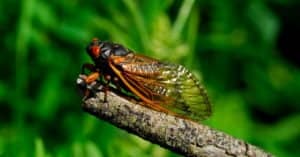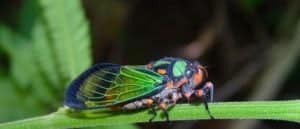Ah, summer is here. The familiar sounds, sights, scents, and undeniable heat have arrived. Many people will find it fascinating that Texas’ summer is heralded by an insect songster with a remarkable life history. Red-eyed bugs with loud, sci-fi-sounding melodies, known as cicadas, can be unsettling.
However, they are not monsters or the locust plague that they seem to be. If you get to know them, you can understand the wonder of these strange creatures. So, what are the cicadas in Texas, and how are they different from other insects?
Cicadas are a common sight in North America, with at least a few different species being seen in Texas. While some of these types are merely slightly different from one another and others have distinctly different traits, they all have several criteria that can be used to categorize them. This article will answer the questions that may be “bugging” you about cicadas in Texas and other interesting facts.
What Makes Cicadas Interesting?
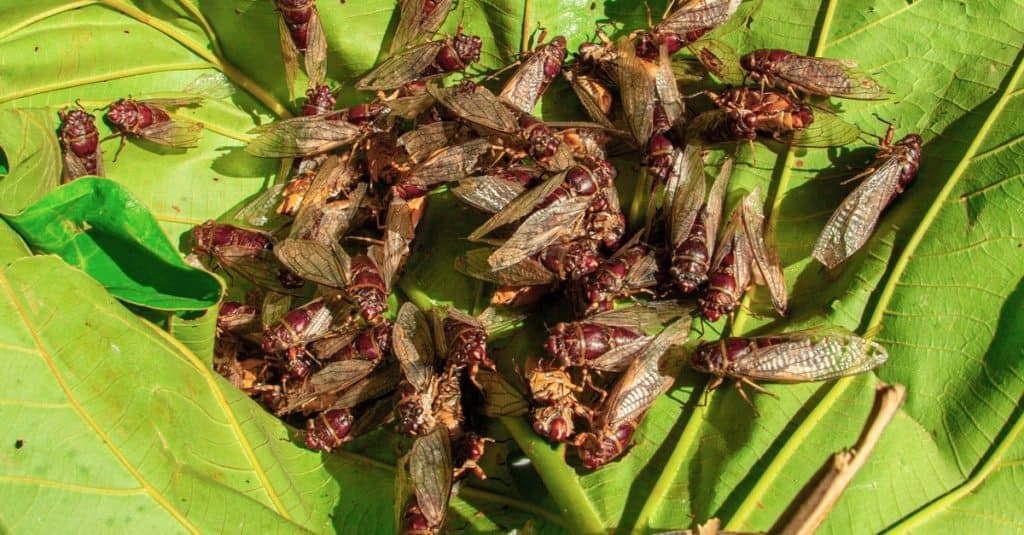
A group of cicadas is known as a brood.
©iStock.com/Photour1904
Cicadas are well known for their ability to make noise, and they typically use this noise either for self-defense or, more frequently, for romantic purposes. All that noise is a cicada mating cry; they mate and lay their eggs in trees. When laying eggs, females make slits in the bark of trees; in six to seven weeks, the egg hatches, and the nymph falls to the ground and burrows in.
Males are songsters and frequently sing non-stop while perched on a tree’s branch, usually in the warmest part of the day. The females in this family are silent and unable to create the same types of music as the males.
The noise can also be used for self-defense. A cicada being attacked by a bird will occasionally scream loudly enough to scare the predator into opening its beak and letting the insect escape to safety.
Cicadas are interesting not only for their noise but also because they have a 13–17 year life cycle. Additionally, there are annual cicadas, species that spring up yearly. Although the life cycles of these cicadas as underground nymphs can range from one to nine years or longer, the emergence of the adults above ground is not coordinated; thus, some individuals of each species appear every year.
As nymphs, they spend most of their lives underground. When something triggers them to rise to the surface, they climb a tree, a wall, or another object, rip open their skin, and become adults. Their sole jobs after this are to reproduce and face death.
Do Cicadas Really Sleep For Years?
Cicadas can experience a form of rest known as torpor, which resembles insect sleep. While no one knows for sure how or why cicadas use a 17-year cycle, some believe they possess an internal molecular clock that tells them when it’s time and the environment is right.
The 17-year cicadas are a type of cicada with the longest-known insect life cycle. They come out like clockwork every 17 years in the northeastern part of the United States. After they hatch from eggs, they spend the first 17 years of their lives underground.
When they finally come out, they only live for about four to six weeks. During this time, they mate, lay eggs, and start the cycle again.
What are the Cicadas in Texas?
The sight and sound of cicadas are two surefire indicators that summer has come in Texas. Contrary to the long life cycles of cicadas from the Midwest, which can last up to 13 to 17 years, Texas cicadas have cycles that last either a year or between two and five years.
Annual cicadas range from about three-quarters of an inch, like the Pacarina puella, a little mesquite cicada found in the valley, to two and a quarter inches, like the giant cicada.
Another Texas singer filling the night air of summer with a decibel-alarming pitch is the giant cicada, Quesada gigas, the largest cicada in the Western Hemisphere and arguably the loudest insect in Texas. The lower half of Texas and beyond, as far south as Argentina, make up the giant cicada’s greatest northern range.
Giant cicadas may be recognized just by their loud, nearly deafening shriek, which has been compared to mechanical equipment and frequently comes with a caution to wear ear protection. The song of the giant cicada has been compared to roaring sirens, alarms, and train whistles.
What Do Cicadas Look Like?
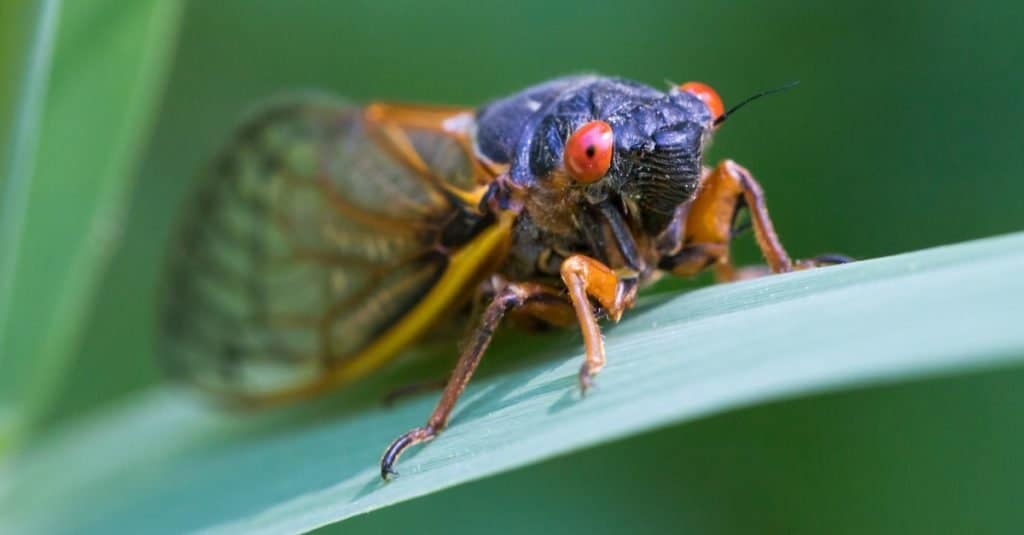
Like majority of other insects, cicadas have six legs delicate orange veins.
©Elliotte Rusty Harold/Shutterstock.com
Cicadas are members of the Magicicada genus, so-called because of the way the insects seem to appear like magic. Then, suddenly, they disappear as if by magic too. The Latin origins of the word “cicada” purportedly describe the insect’s sound.
The bug has six legs, like the majority of other insects. Their wings have delicate orange veins, which one can see through. The insect’s abdomen can be orange, black, or orange and black striped, and its thorax, or the center half of the body, is often black. The insect’s eyes are a blatant red color. Like other insects, the cicada’s skeletal system is outside its body, called an exoskeleton.
Although it is smaller than the annual cicada, which may grow to 2 inches long, the periodical cicada is still a fairly large insect. It is much smaller than the Malaysian emperor cicada, which has an 8-inch wingspan. Female periodic cicadas are larger than males and range in length from 0.9 to 1.3 inches.
Are Cicadas Dangerous?
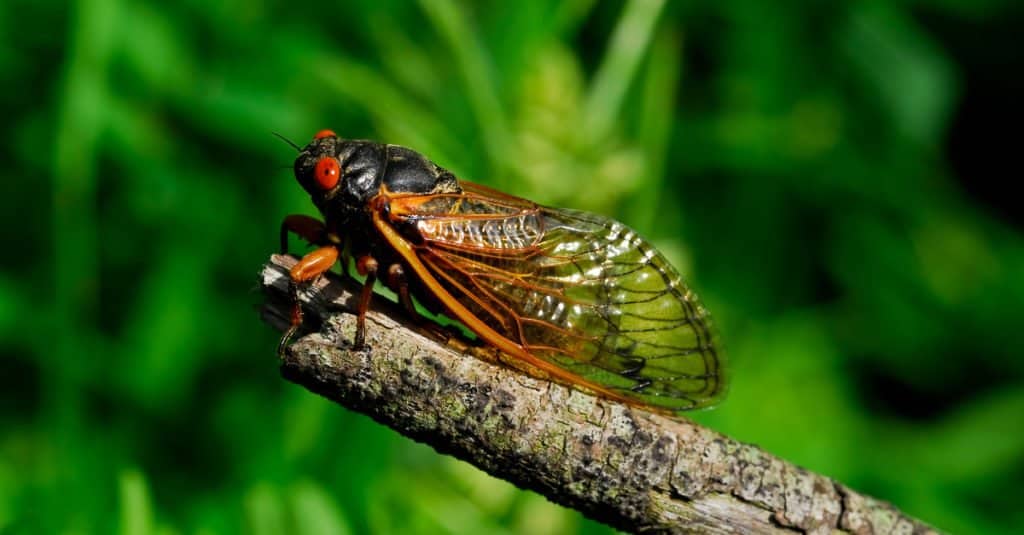
Cicadas are harmless to humans.
©Georgi Baird/Shutterstock.com
Despite their loud calls and aggressive nature, cicada species do not all pose a danger to humans. Even if they become confused or seem to be flying at you, they won’t harm you. There are many misconceptions and falsehoods about this unusual but lovely insect. This fascinating insect’s many qualities include the fact that it is essentially harmless.
In fact, if someone wants to, they can safely eat cicadas. They are comparable to crickets, which are consumed worldwide. They might even become a new part of your diet. Many people find the idea of eating bugs repulsive. However, some cultures frequently use insects as a healthy protein replacement. There is currently no scientific proof of the nutritional value of cicadas. According to the FDA, cicadas should not be taken by anyone allergic to seafood.
Additionally, if they are not a regular part of your pet’s diet, they could cause discomfort or digestive issues. These winged insects are one of the things dogs and cats love to eat.
Do Cicadas Attract Snakes?
No. One common environmental myth is that there are more snakes during cicada season. In reality, only the snakes in hiding come out when cicada activity increases.
Even though copperhead snakes are extremely adept at hiding from view, they are present throughout the forests. Any snakes observed sunning on rocks or snatching cicadas have merely emerged from their dens for this historic occasion. But according to research, copperheads will travel up to a mile from their typical habitat to the cicada feast.
The photo featured at the top of this post is © Marcos Cesar Campis/Shutterstock.com
Thank you for reading! Have some feedback for us? Contact the AZ Animals editorial team.



